Aklavik
Aklavik /əˈklævɪk/ (Inuvialuktun: Akłarvik) (from the Inuvialuktun meaning barrenground grizzly place[4]) is a hamlet located in the Inuvik Region of the Northwest Territories, Canada. Until 1961, with a population over 1,500, the community served as the regional administrative centre for the territorial government. Building conditions at the time considered to be unsuitable (primarily due to flooding) resulted in the development of Inuvik 63 km (39 mi) to the east, meant to entirely replace Aklavik. However, many residents persevered and kept Aklavik as a community, with a 2016 population of nearly 600. The mayor of Aklavik is Andrew Charlie.[3]
Aklavik
Akłarvik | |
|---|---|
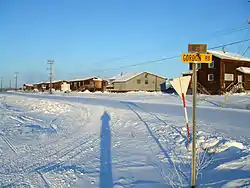 Aklavik in early-February 2008 | |
 Flag | |
| Motto(s): Never Say Die[1] | |
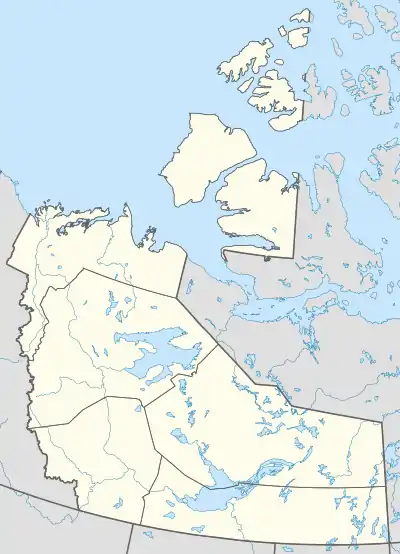 Aklavik  Aklavik | |
| Coordinates: 68°13′13″N 135°00′42″W | |
| Country | Canada |
| Territory | Northwest Territories |
| Region | Inuvik Region |
| Constituency | Mackenzie Delta |
| Census division | Region 1 |
| Incorporated (hamlet) | 1 January 1974 |
| Government | |
| • Mayor | Andrew Charlie |
| • Senior Administrative Officer | Fred Behrens |
| • MLA | Frederick Blake Jr. |
| Area | |
| • Land | 14.47 km2 (5.59 sq mi) |
| Elevation | 6 m (20 ft) |
| Population (2016)[2] | |
| • Total | 590 |
| • Density | 40.8/km2 (106/sq mi) |
| Time zone | UTC−07:00 (MST) |
| • Summer (DST) | UTC−6 (MDT) |
| Canadian Postal code | X0E 0A0 |
| Area code(s) | 867 |
| Telephone exchange | 375 878 978 |
| - Living cost | 162.5A |
| - Food price index | 170.5B |
| Website | www.aklavik.ca |
| Sources: Department of Municipal and Community Affairs[3] Prince of Wales Northern Heritage Centre[4] Canada Flight Supplement[5] ^A 2013 figure based on Edmonton = 100[6] ^B 2015 figure based on Yellowknife = 100[6] Elevation at airport[5] | |
History

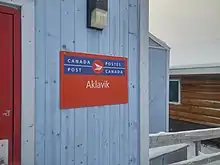
Aklavik began in the early 1900s with the Hudson's Bay Company opening a trading post in 1912 and the Roman Catholic Church establishing a mission in 1926. Located on the Peel Channel, in a good trapping area, the community became a transportation hub in the Mackenzie.
Aklavik became part of the Northwest Territories and Yukon Radio System (NWT&Y) in October 1925. The NWT&Y system, a true pioneer system, was critical in providing communications in Canada's north. and was operated by the Royal Canadian Corps of Signals (RC Sigs). In Aklavik, besides providing services to the general population, NWT&Y also provided communication for any aircraft that overflew the site with or without radio. An aircraft without radio that was simply passing over one of these stations and not destined to land would simply fly very low over the station so that it could be identified and the date and time of its passing would be recorded. The call sign for the NWT&Y station in Aklavik was VEF.
In 1931, Albert Johnson, also known as the "Mad Trapper of Rat River" moved into the area. A complaint was made to the Royal Canadian Mounted Police (RCMP) post in Aklavik and the two members attempted, unsuccessfully, to talk with him concerning trapline tampering. A second attempt was made a few days later, after a search warrant had been obtained, and Johnson shot one of the RCMP. This sparked a 42-day manhunt and ended with the death of Johnson. This incident is famous for introducing the airplane and communications radio as tools to help track a person. Museums dedicated to Albert Johnson can be found in Aklavik and in Fort Smith.
In December 1946, radio station "CHAK" went on the air at Aklavik. The AK in the call sign was the first and last letters of the location. Built and initially operated by WO2 R.A. (Red) McLeod of the RC Sigs, the station was a voluntary operation serving the Mackenzie River delta. It initially had 30 watts of power, later upgraded to 100 watts, and operated on 1490 kHz. It received its license in 1947.
In 1949, the Royal Canadian Navy established a signals intelligence station in Aklavik. It remained operational until March 1961 when it closed down and operations were moved to a brand new station in Inuvik.
By the 1950s the community had developed and grown to over 1,600 people. However, the Peel Channel was subject to flooding, and the river banks were being washed away. Due to the flooding, the Federal Government built a new community at what is now Inuvik, with the intention of closing Aklavik.[4]
In the 1960s, the principal of Aklavik's school, A. J. (Moose) Kerr, started a committee to help save the community. The efforts were successful and the community survived. The local school is named for him.[7]
Today
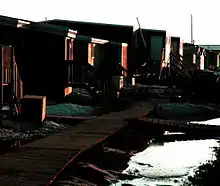
The community has a school with approximately 150 students from Kindergarten to Grade 12[8] and Aurora College provides adult education at the Community Learning Centre.[9]
There are three general stores, the Aklavik General Store, Stantons, and the Northern Store operated by The North West Company.[9] The community has a three-person RCMP detachment, a health centre with four nurses, a Canada Post outlet, the Aklavik Lodge and the Aklavik Inn (Bessie's Boarding House) for visitor accommodation and two taxi companies.[9]
Like most northern communities, Aklavik has a community hall, a gymnasium that is attached to the school and, uncommonly, a swimming pool.[7]
The community is served only by air, via the Aklavik/Freddie Carmichael Airport, and by winter ice road directly from Inuvik across the streams of the Mackenzie Delta. When the river is open, usually June to September,[10] the Aklavik Water Aerodrome is available for float planes.
Land claims
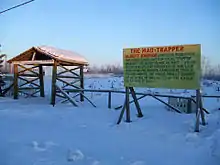
Aklavik is one of the few places in the NWT to be included within two different land claims areas, being part of the Inuvialuit Settlement Region and the Gwich'in Settlement Region.[11][12]
The Inuvialuit, whose claim, the Inuvialuit Final Agreement was settled in 1984,[13] are represented by the Aklavik Community Corporation which in turn forms part of the Inuvialuit Regional Corporation.[14]
The Gwich'in of Aklavik are covered under the Gwich'in Comprehensive Land Claim Agreement, signed in 1992,[15] and are represented by the Ehdiitat Gwich'in Council, as well as the Aklavik First Nation.[16] The Ehdiitat Gwich'in Council in turn forms part of the Gwich'in Tribal Council.[17]
Indigenous peoples
The Inuvialuit of Aklavik, an Inuit people, are primarily Uummarmiut and are descendants of the Nunamiut, Inupiat people who migrated from Alaska in the early 20th century. Although at first antagonistic they later intermarried with the local Siglit, whose numbers had dwindled due to disease.[18] They speak Uummarmiutun, which is almost identical to Inupiaq language but is grouped with Inuvialuktun.[19]
The Gwich'in, a First Nations people are an Arctic-dwelling Dene peoples who inhabit Alaska, Yukon and the NWT. They speak the Gwichʼin language which is part of the Athabaskan language family.[20]
Both Inuvialuktun and Gwichʼin are official languages of the NWT, and in 2009 19.2% of the Aboriginal population spoke at least one Native language.[6][21]
Climate
Aklavik has a subarctic climate (Dfc), typical of Canada's Arctic, with mild summers and cold winters lasting most of the year with highs regularly below zero. Freezing can occur at any time of the year.
| Climate data for Aklavik/Freddie Carmichael Airport | |||||||||||||
|---|---|---|---|---|---|---|---|---|---|---|---|---|---|
| Month | Jan | Feb | Mar | Apr | May | Jun | Jul | Aug | Sep | Oct | Nov | Dec | Year |
| Record high humidex | 10.5 | 2.0 | 8.1 | 16.6 | 27.8 | 35.7 | 35.5 | 33.8 | 26.5 | 16.4 | 4.3 | 5.5 | 35.7 |
| Record high °C (°F) | 6.7 (44.1) |
9.4 (48.9) |
11.0 (51.8) |
14.2 (57.6) |
25.0 (77.0) |
31.8 (89.2) |
33.9 (93.0) |
31.9 (89.4) |
27.6 (81.7) |
17.0 (62.6) |
6.7 (44.1) |
10.0 (50.0) |
33.9 (93.0) |
| Average high °C (°F) | −22.3 (−8.1) |
−21.7 (−7.1) |
−16.4 (2.5) |
−6.7 (19.9) |
4.6 (40.3) |
16.5 (61.7) |
18.4 (65.1) |
15.0 (59.0) |
7.6 (45.7) |
−4.9 (23.2) |
−17.0 (1.4) |
−20.9 (−5.6) |
−4.0 (24.8) |
| Daily mean °C (°F) | −26.3 (−15.3) |
−25.7 (−14.3) |
−21.7 (−7.1) |
−12.5 (9.5) |
−0.1 (31.8) |
11.4 (52.5) |
13.9 (57.0) |
10.9 (51.6) |
4.4 (39.9) |
−7.6 (18.3) |
−20.7 (−5.3) |
−24.7 (−12.5) |
−8.2 (17.2) |
| Average low °C (°F) | −30.2 (−22.4) |
−29.8 (−21.6) |
−27.0 (−16.6) |
−18.2 (−0.8) |
−4.8 (23.4) |
6.2 (43.2) |
9.4 (48.9) |
6.8 (44.2) |
1.2 (34.2) |
−10.2 (13.6) |
−24.2 (−11.6) |
−28.4 (−19.1) |
−12.4 (9.7) |
| Record low °C (°F) | −51.0 (−59.8) |
−52.2 (−62.0) |
−48.9 (−56.0) |
−42.2 (−44.0) |
−25.6 (−14.1) |
−6.7 (19.9) |
−11.1 (12.0) |
−3.9 (25.0) |
−14.0 (6.8) |
−35.1 (−31.2) |
−45.6 (−50.1) |
−47.8 (−54.0) |
−52.2 (−62.0) |
| Record low wind chill | −59.8 | −61.5 | −52.8 | −46.0 | −31.5 | −11.4 | 0.0 | −6.0 | −16.4 | −41.1 | −49.7 | −56.4 | −61.5 |
| Average precipitation mm (inches) | 15.0 (0.59) |
11.9 (0.47) |
13.8 (0.54) |
8.0 (0.31) |
14.8 (0.58) |
19.4 (0.76) |
40.6 (1.60) |
41.7 (1.64) |
30.6 (1.20) |
32.6 (1.28) |
22.0 (0.87) |
15.6 (0.61) |
265.8 (10.46) |
| Average rainfall mm (inches) | 0.0 (0.0) |
0.0 (0.0) |
0.0 (0.0) |
0.1 (0.00) |
5.4 (0.21) |
18.5 (0.73) |
40.6 (1.60) |
41.3 (1.63) |
23.7 (0.93) |
0.3 (0.01) |
0.0 (0.0) |
0.0 (0.0) |
129.8 (5.11) |
| Average snowfall cm (inches) | 15.0 (5.9) |
11.9 (4.7) |
13.8 (5.4) |
8.0 (3.1) |
9.5 (3.7) |
0.9 (0.4) |
0.0 (0.0) |
0.4 (0.2) |
6.9 (2.7) |
32.3 (12.7) |
22.2 (8.7) |
15.6 (6.1) |
136.3 (53.7) |
| Average precipitation days (≥ 0.2 mm) | 7.8 | 7.8 | 7.1 | 5.3 | 5.8 | 7.1 | 10.8 | 11.3 | 12.5 | 11.6 | 9.9 | 8.9 | 105.8 |
| Average rainy days (≥ 0.2 mm) | 0.0 | 0.0 | 0.0 | 0.0 | 2.1 | 6.7 | 10.8 | 11.3 | 10.4 | 0.5 | 0.0 | 0.0 | 41.9 |
| Average snowy days (≥ 0.2 cm) | 7.8 | 7.8 | 7.1 | 5.2 | 3.8 | 0.3 | 0.0 | 0.1 | 2.2 | 11.5 | 9.9 | 8.9 | 64.6 |
| Mean monthly sunshine hours | 13 | 94 | 177 | 277 | 297 | 401 | 276 | 206 | 95 | 72 | 22 | 0 | 1,930 |
| Source 1: Environment Canada Canadian Climate Normals 1981–2010[22] | |||||||||||||
| Source 2: Danish Meteorological Institute (sun, 1931–1960)[23] | |||||||||||||
Demographics

|
| ||||||||||||||||||||||||||||||||||||||||||||||||||||||||||||||||||||||||
| Sources: NWT Bureau of Statistics (2001 - 2017)[24] | |||||||||||||||||||||||||||||||||||||||||||||||||||||||||||||||||||||||||
At the 2016 census, Aklavik had a population of 590, down 6.8% from 2011.[2] Like most other NWT communities the majority of the population, 93.2%, is Indigenous. However, unlike other communities Aklavik has a large number of both First Nations, 33.9%, and Inuit, 53.4%, along with a small number of Métis, 4.2%, and non-Aboriginal, 8.5%.[2]
In 2017 the Government of the Northwest Territories reported that the population was 656 with an average yearly growth rate of 0.7% from 2006. From 2006 to 2014 there were 94 births and 42 deaths in the community. In 2017, 14% of residents were 9 or under, 6.9% were from 10 to 14 years old, 14.2% were from 15 to 24, 30.9% were from 25 to 44, 20% were from 45 to 59, and 14% were 60 or older.[6] At the 2016 census the median age in Aklavik was 31.8, compared to 34.0 for the NWT and 41.2 for Canada as a whole.[2][25]
The crime rate for 2016 was 70.9 (per 1,000 persons) for violent crimes, and 200.9 (per 1,000 persons) for property crimes, both numbers below the average for the NWT of 78.4 and 206.6.[6] In 2015 the average income in the hamlet was C$33,826, compared to $61,909 for the NWT, and the average income for a family was $80,200, compared to $133,754 for the NWT, with 20.0% of all families earning less than $30,000.[6]
Notable people
- Frank Carmichael, trapper and former MLA for Mackenzie West and Mackenzie Delta
- Nellie Cournoyea, former Premier of the Northwest Territories
- Glenna Hansen, former Commissioner of the Northwest Territories
- Robert C. McLeod, MLA for Inuvik Twin Lakes
- Abe Okpik, first Inuk on the Legislative Assembly of the Northwest Territories and spearheaded Project Surname to replace disc numbers
- Rick Rivet, Sahtu–Métis Neo-Expressionist painter[26]
- Vince Steen, former MLA for Nunakput
- Willie Thrasher, musician
References
- About Aklavik
- "NWT Community and Dwelling Counts 1981-2016". Statistics Canada. Stats NWT. 8 February 2017. Retrieved 23 February 2018.
- "NWT Communities - Aklavik". Government of the Northwest Territories: Department of Municipal and Community Affairs. Retrieved 23 February 2018.
- "Northwest Territories Official Community Names and Pronunciation Guide". Prince of Wales Northern Heritage Centre. Yellowknife: Education, Culture and Employment, Government of the Northwest Territories. Archived from the original on 13 January 2016. Retrieved 13 January 2016.
- Canada Flight Supplement. Effective 0901Z 16 July 2020 to 0901Z 10 September 2020.
- "Aklavik - Statistical Profile (2006-2017)" (PDF). NWT Bureau of Statistics. Archived (PDF) from the original on 29 August 2018.
- Moose Kerr School at the Beaufort-Delta Education Council Archived 15 April 2008 at the Wayback Machine
- "Moose Kerr School at Windows Around the World". Archived from the original on 21 March 2014. Retrieved 20 February 2008.
- Northwestel phone directory
- Nav Canada's Water Aerodrome Supplement. Effective 0901Z 26 March 2020 to 0901Z 22 April 2021.
- Inuvialuit Settlement Region
- Gwich'in Settlement Region Archived 24 September 2010 at the Wayback Machine
- Inuvialuit Land Claim
- Corporate Structure Archived 29 January 2010 at the Wayback Machine
- Gwich'in Arbitration Panel Archived 6 July 2011 at the Wayback Machine
- "Ehdiitat Gwich'in Council". Archived from the original on 18 January 2011. Retrieved 20 May 2010.
- GTC Chart (Governance) Archived 18 May 2011 at the Wayback Machine
- People of Mackenzie River
- Iñuvialuktun/Inuvialuktun/Inuinnaqtun / ᐃᓄᐃᓐᓇᖅᑐᓐ
- History
- Northwest Territories Official Languages Act, 1988 Archived 24 March 2009 at the Wayback Machine (as amended 1988, 1991-1992, 2003)
- "Aklavik A" (CSV (3069 KB)). Canadian Climate Normals 1981–2010. Environment Canada. Climate ID: 2200100. Retrieved 9 January 2014.
- Cappelen, John; Jensen, Jens. "Canada - Aklavik, Mackenzie District" (PDF). Climate Data for Selected Stations (1931-1960) (in Danish). Danish Meteorological Institute. p. 45. Archived from the original (PDF) on 27 April 2013. Retrieved 14 March 2016.
- Population Estimates By Community from the GNWT
- Profile, 2016 Census Aklavik, Hamlet (Census subdivision), Northwest Territories and Canada (Country)
- "The Fellows: 1999." Archived 18 October 2018 at the Wayback Machine Eiteljorg Fellowship for Native American Fine Art. Accessed 4 May 2014.